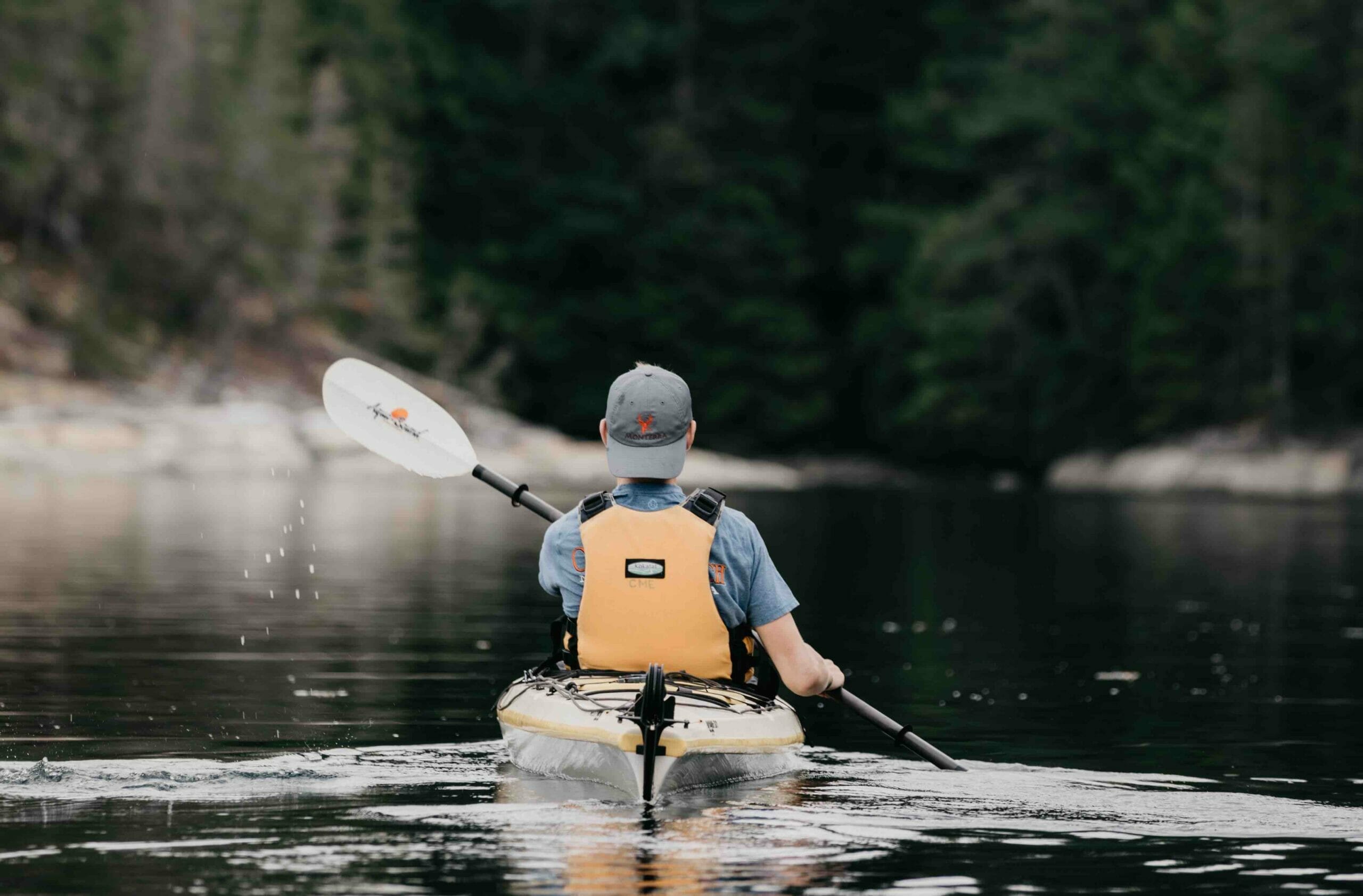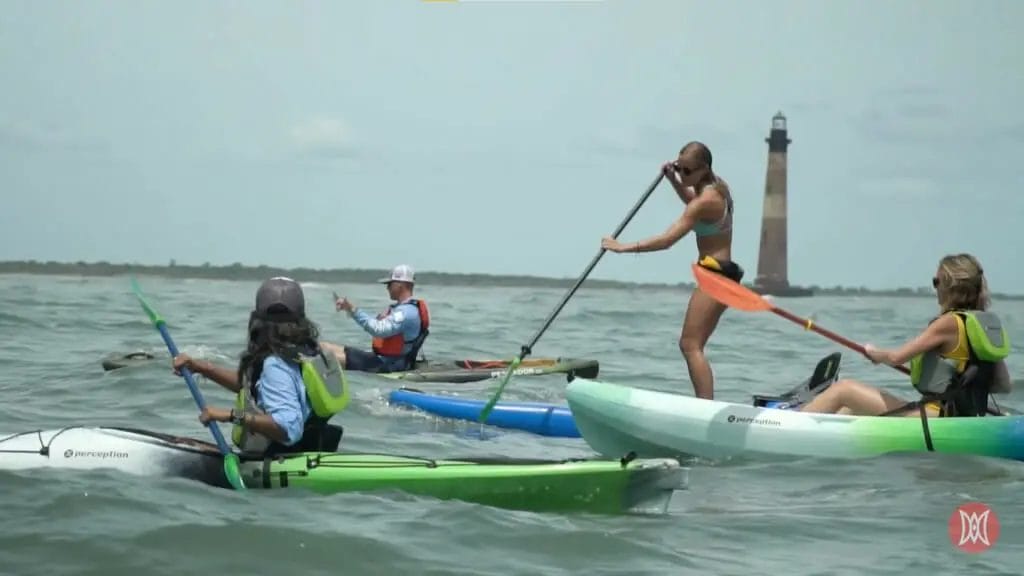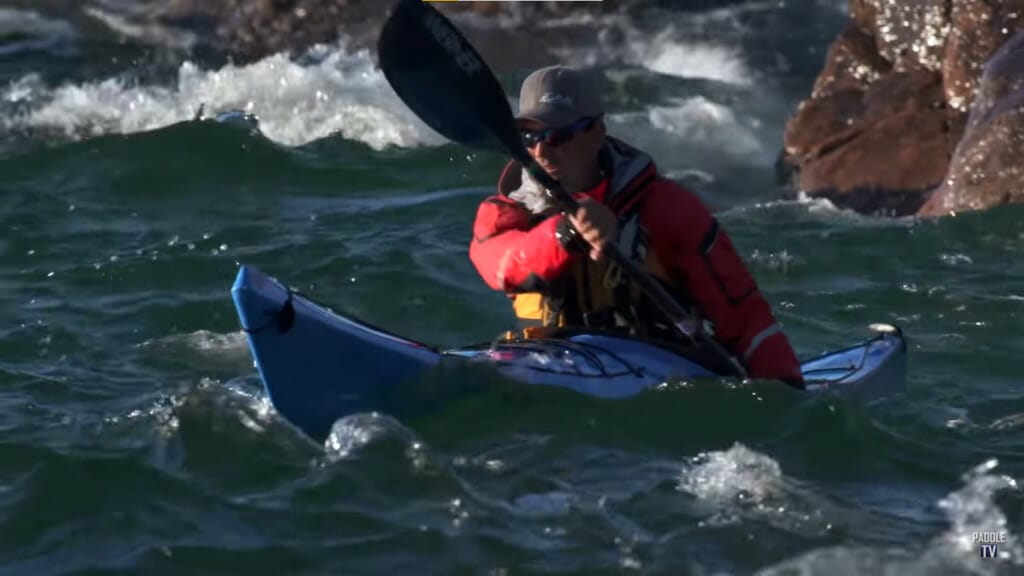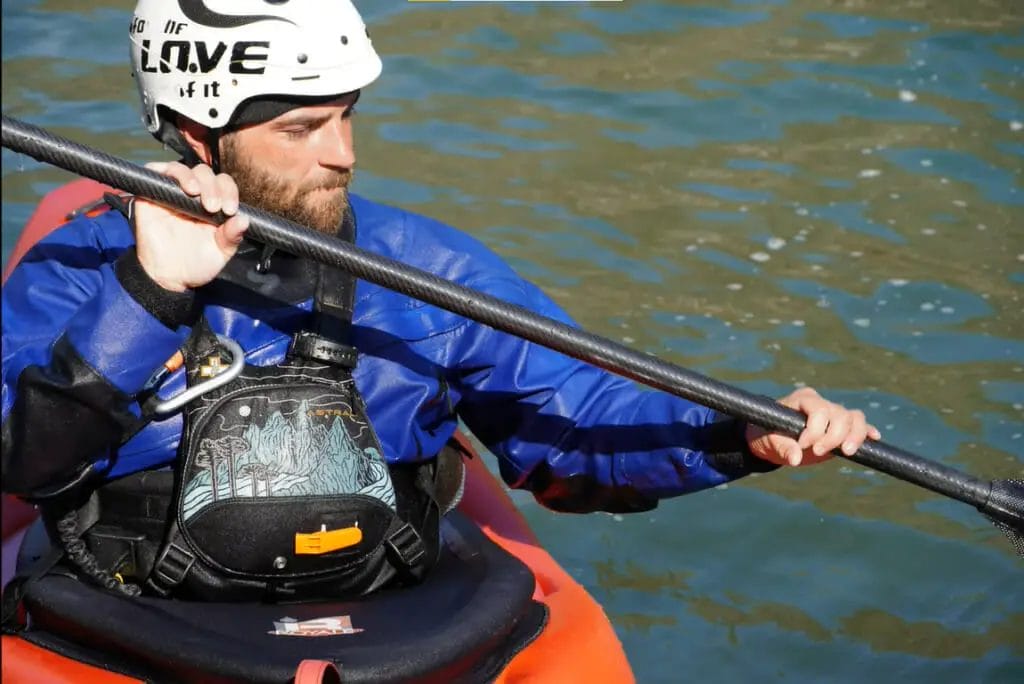How Fast Do Kayaks Go? (Factors & MPH Speeds)

Kayaks aren’t the fastest on the water, but in the hands of an experienced kayaker, they can surprise many.
Kayaks typically move at a speed of two miles per hour. This number is the baseline that the average kayaker can reach. In more experienced hands, the average kayak speed is usually 5 miles per hour. In comparison, its maximum recorded speed is 39 miles per hour. Multiple physical and environmental factors can increase or decrease a kayak’s speed.
The following are generalizations and can be affected by many factors, including kayak size, make, design, and paddler-centric factors.
- Touring kayaks: 4-8 mph
- Sea kayaks: 3-6 mph
- Whitewater kayaks: 2-7 mph (depending on water conditions)
- Fishing kayaks: 2-6 mph (depending on the design of the kayak)
- Recreational kayaks: 2-4 mph
Improve your average kayaking speed by learning about the tips and tricks behind kayaking.
The Average Kayaking Speed

Kayakers typically average two miles per hour (3.22 km per hour) when paddling.
Many consider this average kayak speed to be the baseline that most kayakers, including both beginners and experienced ones, can reach when traveling long distances. This number accounts for short breaks and stamina-conservation practices, so it’s reasonable to expect that you can travel for 8 to 10 miles in the span of 4 to 5 hours.
It’s important to note that shorter distances traveled can mean higher kayak speeds.
Shorter distances mean fewer reasons to take breaks and conserve stamina.
The average kayak speed is slightly slow compared to the average walking speed.
According to the Centers for Disease Control and Prevention, the average walking speed is 2.5 to 4 miles per hour (4.02 to 6.44 km per hour). It’s jarring to think that walking is faster than kayaking, but that’s because kayaking has many underlying physical and environmental factors that affect its overall speed. [1]
The Maximum Speed that Kayaks can Reach

We talked about how fast the average kayak speed is, but how fast can it go?
According to the Guinness Book of World Records, the record for the fastest kayaking speed is 39 miles per hour (62.94 km per hour). While it’s amazing to think you can reach that extraordinary speed on a kayak, it shouldn’t be your baseline for how fast kayaks can go.
Experienced and fit kayakers can reach an average speed of 5 miles per hour (8.05 km per hour).
Maintaining the mentioned average kayak speed of mph is difficult for long periods. Many kayakers only reach those speeds when competing in short-distance kayak races – where it is expected to go all in from the start. However, if the current and wind conditions are favorable, kayakers can reach those speeds over long distances.
Factors that Affect How Fast Kayaks Go
Multiple physical and environmental factors affect how fast kayaks can go, some uncontrollable and purely based on chance. However, you can improve your average speed by identifying which factors you can control and minimize.
Here are the key factors that affect your average speed.
1. The Type of Kayak

- Touring kayaks: 4-8 mph
- Sea kayaks: 3-6 mph
- Whitewater kayaks: 2-4 mph (depending on water conditions)
- Fishing kayaks: 2-6 mph (depending on the design of the kayak)
- Recreational kayaks: 2-4 mph
If you disregard all other physical and environmental factors, your choice of kayak type has the biggest impact on your average speed.
Generally, long kayaks with a narrow beam travel fastest since they have higher hull speeds. Hull speed refers to the speed at which the kayak drags itself over the length of a wave. Long kayaks are narrower and have less surface area for the water to cover. This reduces the amount of drag or friction when traveling over the water, making long kayaks the preferred type for races and speed-based activities.
Long kayaks with narrow beams can remove up to 10 minutes from your average time, thanks to their superior hull speed.
The main downside to using long kayaks is their inefficiency in turning. The narrow design makes it hard to turn and redirect, especially if sharp turns are needed, so it’s crucial to preplan your route to avoid delays caused by reorienting the kayak.
2. The Kayak Weight
Lightweight kayaks are preferred if you’re interested in increasing your average speed.
Lightweight kayaks offer less resistance and are easier to move. Less effort and power are needed to paddle them. They can easily generate momentum to maintain a high average speed.
Don’t be deceived; heavier kayaks have advantages over lightweight ones.
While heavier kayaks need more power and effort to move them, they sit more stable in the water than their lightweight counterparts. It’s easier for kayakers to keep the momentum they gained without getting interrupted. Heavier kayaks are less likely to be affected by environmental conditions like wind speed and current flow.
3. The Paddle

List of Factors
- Blade Shape: Paddles with longer, narrower blades tend to be more efficient, as they can slice through the water more easily. On the other hand, wide blades are less efficient and may cause the paddler to tire more quickly.
- Blade Material: Paddles made of lightweight materials, such as carbon fiber or fiberglass, tend to be faster than heavier paddles made of aluminum or plastic.
- Length of Paddle: The length of the paddle can also affect speed. A longer paddle can provide more leverage, making paddling easier and potentially faster. However, longer paddles may also be more cumbersome and less maneuverable.
- Shaft Material: The material of the paddle shaft can also affect the speed of your kayaking. Paddles with flexible shafts may be more comfortable, but they may also be less efficient and slower than paddles with stiffer shafts.
The kayak paddles’ design impacts how efficiently you can move the kayak through the water.
Paddles with a blade design cut through the water easily, allowing the user to generate more power throughout each stroke. This reduces the effort needed to transfer energy from your body to the paddle.
It would be best if you also considered getting a lighter kayak paddle to improve the kayak’s speed further.
Lighter paddles mean less energy is needed to hold and use them. It is easier to maintain consistent and strong strokes for longer periods. Some examples of lightweight materials for your paddles are carbon fiber, wood, and fiberglass.
4. Water Flow

- Flatwater (e.g., calm lakes, slow-moving rivers): A kayak on flatwater can typically achieve top speeds of 5-10 mph, depending on the kayak’s design and the paddler’s skill and strength.
- Choppy Water (e.g., waves on a lake or ocean): The speed of a kayak on choppy water will depend on the size and frequency of the waves, the kayak’s design, and the paddler’s skill and strength. A kayak may be able to maintain a similar speed as on flatwater in small to moderate waves, but larger waves can significantly slow a kayak down.
- Whitewater (e.g., rough, turbulent rivers): The speed of a kayak on whitewater will depend on the specific conditions of the river, such as the size and frequency of the rapids and obstacles. Whitewater kayaks are not designed for maximum speed but for maneuverability in challenging conditions. As such, the top speed of a kayak on whitewater will generally be much lower than on flatwater or choppy water, often in the range of 2-4 mph.
Kayaks are meant to travel over bodies of water, so water flow has the second largest impact on how fast your kayak can go.
Traveling downstream with the water can make your kayak faster. The water will propel the kayak forward without the need for strenuous paddling. However, it would be best if you were cautious when moving through downstream rapids. Kayaks are prone to get knocked off course and dragged away by strong water flow.
Calm, flat waters offer kayakers little to no help to propel the kayak forward.
For these bodies of water, your kayak speed is determined by your paddle strokes, the hull speed, and the weather conditions. In other words, your kayak speed mostly depends on your skill and physique as a kayaker. Calm waters are the perfect environment to practice and improve your form and paddle strokes.
The ocean is one of the toughest bodies of water for kayakers to travel through.
Kayakers should lookout for tide shifts when paddling through saltwater. Tide shifts can easily shift the current flow and change the terrain of the area you’re in. Aside from possibly creating tricky terrain, the current changes can either assist or hinder the top miles hour speed your kayak can reach.
5. The Wind and Weather Conditions
Wind and weather conditions are both the boon and bane of many kayakers.
Wind, in particular, greatly impacts how well your kayak can travel. The two things to keep in mind are the strength and direction of the wind. Traveling in the direction of the wind will help propel the kayak. It acts as a tailwind that will blow the kayak forward, letting you travel faster without needing strong paddle strokes.
Kayakers traveling in the same direction as the wind can expect to reach an average kayak speed of 5 miles per hour (8.05 km per hour). Meanwhile, those going against the wind may slow down by 2 miles per hour (3.21 km per hour).
Plan your kayaking adventures to avoid any adverse weather conditions. Doing so will help keep you safe during your time on the water and minimize unwanted weather conditions’ effects on your performance.
6. Stamina and Experience of the Paddler

Physical prowess is still the name of the game when it comes to kayaking.
You’ll need a lot of skill and stamina to achieve high speeds in kayaking. Muscle strength and stamina are needed to produce strong paddle strokes to propel the kayak forward consistently. Also, a certain degree of skill is required to make the best of efficient paddling techniques.
Contrary to popular belief, upper body strength isn’t the most important in paddling.
Most of the power needed to perform paddle strokes directly comes from your core strength. A stable core keeps your body centered and allows you to place more energy and power behind each stroke. It also keeps your body in the correct paddling posture for hours.
While high-quality kayaks and paddles can improve your top speeds, your physique is still the main driving force behind kayaking. It’s important to stay in shape to maintain or improve your average kayak speed.
Tips to Improve Your Kayaking Speed
There are no shortcuts to improving your times and overall kayak speed, but there are some helpful tips to help you be faster.
Engage Your Body’s Muscles

The key to generating powerful paddle strokes is fully utilizing the large muscles in your shoulders, back, and core.
Faster strokes don’t automatically mean a faster kayak. On the contrary, generating a powerful, controlled stroke can propel you faster than multiple short ones. Strength is needed to generate momentum and push the kayak forward. Accelerating and maintaining a high speed becomes easier once you gain initial momentum.
It’s important to train and engage the right muscle groups to properly generate and translate the energy from your body to the paddles.
Practice Proper Body Positioning
Proper body positioning is needed to engage your muscles. After all, you cant expect to fully utilize your physical prowess if you’re slouching in your seat.
Get into the proper position by placing both feet on the foot pedals or footrests of the kayak. Straighten your back and keep your knees slightly bent. Don’t be too rigid; your muscles must be flexible enough to follow through each paddle stroke.
Another benefit of staying in the proper position is increased attentiveness.
It’s easier to stay alert and aware of your surroundings when your body is engaged. This allows you to easily note any weather and current changes and upcoming obstacles in the terrain.
Learn Proper Paddle Techniques

A good paddling technique is placing your hand higher on the opposite side of the blade dipped into the water. This will shift the paddle to a higher angle relative to the water’s surface, making it easier to dip the blade. As a result, more power is generated once you propel the kayak forward using the paddle.
Keep your grip relaxed when paddling.
Relaxing your grip allows you to minimize fatigue and keep consistent paddle strokes. Your fingers should loosely support the paddle’s weight while your palm gently pushes the paddle forward.
Take advantage of calm, flat waters to practice your paddling techniques. This environment has the least amount of uncontrollable factors, making it easy to try out and perfect your form.
Keep the Kayak’s Weight Light
We emphasized the importance of keeping your kayak light. However, there are other ways of doing so than just using a lightweight kayak.
Bringing supplies like water, snacks, and emergency provisions is expected when traveling long distances on a kayak. These supplies add to the overall weight of your kayak. We’re not telling you to remove those things completely, but you should practice bringing only necessities. Doing so will reduce unwanted weight from the kayak and improve your average speed.
Carefully consider what supplies you need and your kayak’s weight before setting off.
Take a look at some of our related articles below.
Reference
[1] walking – Centers for Disease Control and Prevention – www.cdc.gov/physicalactivity/walking/index.htm
Video References
Perception Kayaks
Hans Mallmann
Headwaters Kayak
GoPro
PaddleTV
West Marine
Ace Kayaking School
